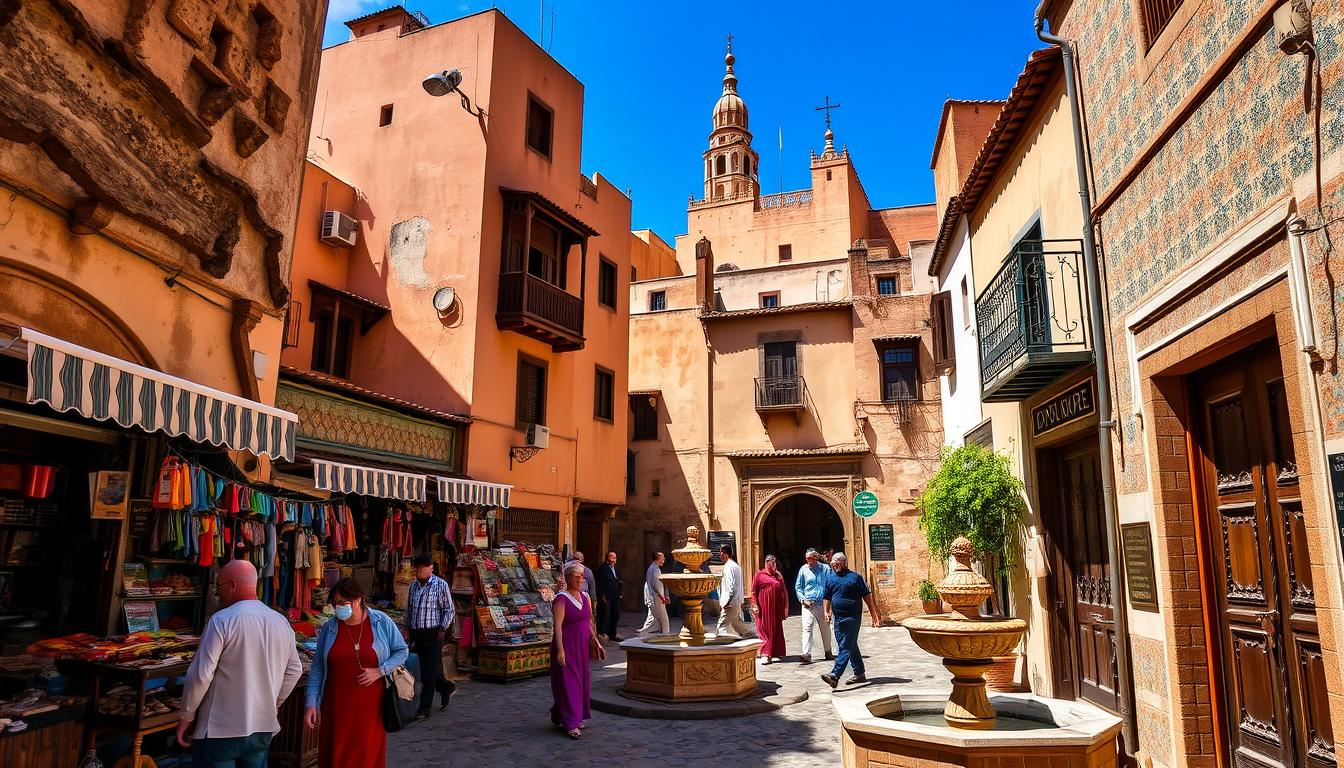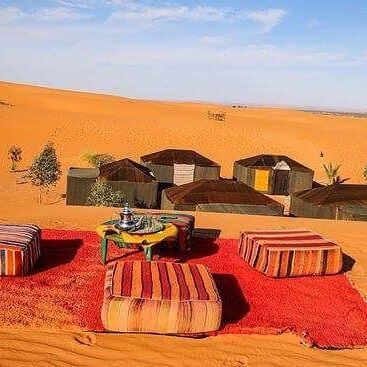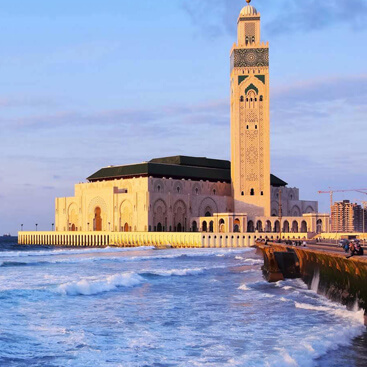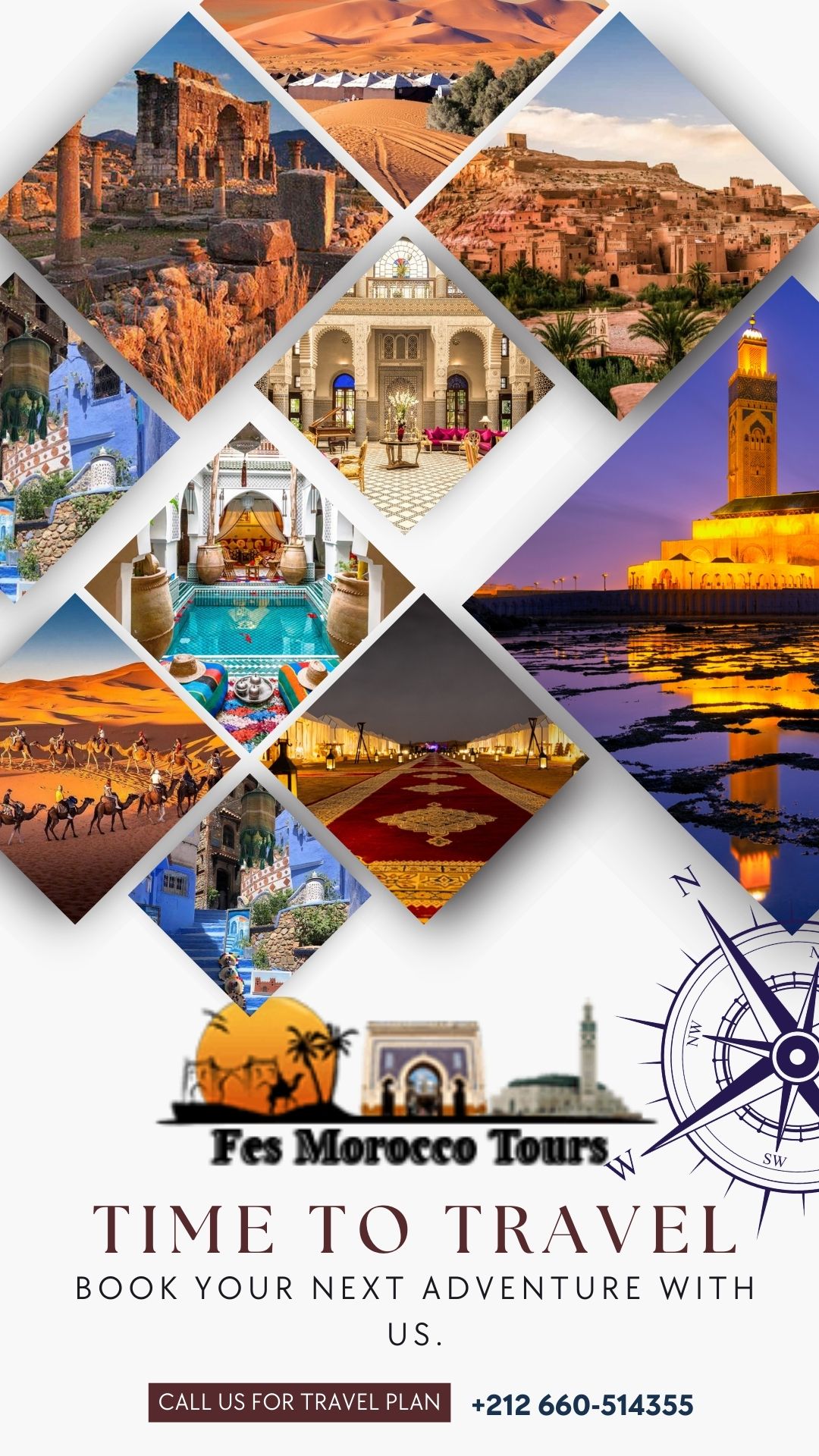
Top 10 Must-See Attractions in Fès, Morocco: A Guide for First-Time Visitors
As you enter Fès, Morocco, you'll feel like you've stepped back in time. The city's medina, souks, and architecture will amaze you. This guide will show you the top 10 sights in Fès, a true gem in North Africa.
Fes Morocco Tours
A vibrant scene of Fès Medina, showcasing narrow winding streets lined with colorful market stalls, intricate tile work on ancient buildings, locals dressed in traditional attire, the aroma of spices wafting through the air, and glimpses of historic fountains and wooden doors, all under a bright blue sky.
Key Takeaways
- Fès is one of the oldest continuously inhabited cities in the world, dating back to the 9th century.
- The city is renowned for its UNESCO World Heritage-listed medina, the largest car-free urban area globally.
- Immerse yourself in the rich history and cultural significance of Fès, a center of Islamic learning and artistry for centuries.
- Explore the iconic Chouara Tannery, where the traditional leather-making process has remained unchanged for over a millennium.
- Discover the architectural marvels of Fès, including the Al-Qarawiyyin Mosque, the world's oldest university, and the stunning Bou Inania Madrasa.
Exploring the Ancient Medina of Fès
Get ready to explore the world's largest car-free urban area - the Medina of Fès, Morocco. This UNESCO World Heritage site dates back to the 9th century. It's a maze of over 9,000 narrow alleys in the historic Fes el Bali district. Navigating this area can be thrilling but also challenging, especially for first-timers.
That's why a guided fes medina excursions or fes city tours is recommended. They help you discover the medina's wonders.
The Fès Medina holds great historical value. Founded in 789 AD by the Idrisid dynasty, it's one of Morocco's four imperial cities. In 1981, UNESCO named it a World Heritage Site. This recognition highlights its importance and the need to protect this morocco travel guide treasure.
Best Time to Visit the Medina
The best times to visit the Fès Medina are spring (March-May) and fall (September-November). The weather is mild and pleasant during these seasons. Try to avoid the hot summers and cold winters, as the medina can be uncomfortable then.
"Vibrant and bustling streets of Fès Medina, showcasing intricate Moroccan architecture, colorful souks filled with spices and textiles, traditional craftsmen at work, historic mosques in the background, and lively market scenes under a clear blue sky."
"The medina of Fès is a true living museum, where the past and present coexist in perfect harmony. Wandering through its maze-like alleys is an experience that will stay with you long after your visit."
Whether you explore the Medina alone or with a guided tour, you'll dive into a world of history, culture, and traditional crafts. The Fès Medina offers a unique look into Morocco's heritage. It's a chance to connect with the local way of life.
The Iconic Chouara Tannery: A Living History
In the heart of Fes Medina, a UNESCO World Heritage Site, is the Chouara Tannery. It's a living piece of Morocco's leather-making history. This ancient tannery, over a thousand years old, is the largest and oldest in the world. It shows visitors how leather-making has been done for generations.
The tanning methods at Chouara Tannery are amazing. They use natural stuff like pigeon feces, lime, and vegetable dyes. This turns raw hides into the soft, colorful leathers known for Moroccan craftsmanship. Visitors can see the skilled artisans at work. They get to experience the sights, sounds, and smells of this iconic place.
To see the dye pits and workers from above, go to the rooftop terraces of nearby leather shops. These spots give a great view of the tannery. The strong smells might be hard to get used to, but seeing this ancient craft is unforgettable.
"Exploring the Chouara Tannery was a highlight of my trip to Fes. Seeing the artisans at work and the vibrant colors of the dye pits was a truly mesmerizing experience that transported me back in time."
If you love history, Moroccan architecture, or just want a unique experience, the Chouara Tannery is a must-see. It will make your Moroccan trip unforgettable.
Al-Qarawiyyin Mosque and University Complex
In the heart of Fes, the Al-Qarawiyyin Mosque and University Complex is a key spot for history lovers. Founded in 859 AD, it's the oldest university still in use today. It's a highlight for those interested in Moroccan and North African heritage.
World's Oldest University
The Al-Qarawiyyin University has a history over 1,200 years old. It's the oldest university that never stopped teaching. It has greatly influenced the area's culture and knowledge.
Architectural Highlights and Religious Significance
The Al-Qarawiyyin Mosque is Morocco's second-largest mosque. It boasts beautiful marble courtyards, fountains, and carvings. Though non-Muslims can't enter, they can see its beauty from the entrance.
Viewing Guidelines for Non-Muslims
Non-Muslims can't go inside the mosque but can see it from rooftops. This way, they can admire the mosque's beauty and its importance without disrespecting it.
"The Al-Qarawiyyin Mosque and University Complex is a true testament to Morocco's rich history and cultural heritage, offering visitors a unique glimpse into the country's enduring legacy of Islamic learning and architectural excellence."
Bou Inania Madrasa: Marvel of Islamic Architecture
For those on fes cultural tours, islamic architecture tours, or moroccan architecture tours, the Bou Inania Madrasa is a must-see. This 14th-century marvel showcases the region's rich Islamic heritage.
Walking into the madrasa's marble courtyard, you'll be amazed by the wood carvings and mosaic tilework. The green minaret of the mosque stands out. The design's detail and blend make it a wonder of islamic architecture.
The Bou Inania Madrasa is special because it's open to non-Muslim visitors. This lets you dive into its history and beauty. You'll appreciate the cultural and architectural legacy of the region more.
"The Bou Inania Madrasa is a true testament to the enduring spirit of Moroccan craftsmanship and the timeless beauty of islamic architecture."
Whether you love history, architecture, or just want a cultural experience, visit the Bou Inania Madrasa. It's open from 9 AM to 5 PM (except prayer times). With an entrance fee of 20 Dhs (2 USD), it's an unforgettable experience.
Fes Morocco Tours: Guided Cultural Experiences
Exploring Fès, Morocco, is a journey filled with history and culture. Local experts make it even better. They share the city's history, architecture, and traditions.
Popular Tour Routes and Options
There are many tours to choose from. You can walk through the ancient Medina or visit artisan workshops. You can also try food tours and see the city's biggest car-free area.
Marvel at the Al-Qarawiyyin Mosque and Bou Inania Madrasa. Explore the souks and craft studios. Each tour offers a unique way to see Fès.
Local Guide Benefits
Local guides are key to exploring Fès. They know the Medina well and share its history. They also take you to places you can't find on your own.
These guides offer a deep dive into Fès' culture. They connect you with the community. This makes your visit unforgettable.
Cultural Immersion Activities
- Learn to cook Moroccan dishes in a traditional class
- Visit local homes to see daily life up close
- Watch artisans create traditional Fès crafts
Choosing a guided fes morocco tours, guided cultural tours, or fes guided walking tours is wise. It lets you dive into Fès' culture and history. Your trip will be memorable and enriching.
Royal Palace of Fès (Dar el Makhzen)
In the heart of Fès, Morocco, the Royal Palace of Fès (Dar el Makhzen) shines. It shows the city's rich culture and stunning buildings. The palace, home to the royal family and government, has amazing walls with blue mosaic tiles and bronze doors that grab everyone's attention.
The palace's inside is not open to visitors. But, the outside is stunning, and the gardens next to it are peaceful. These gardens are a calm spot in the busy city of Fès.
Next to the Royal Palace is the grand mosque Fes el-Jdid. Its minaret is beautifully decorated, adding to the area's beauty. For more history, visit Dar Batha, the former royal palace. It now has a museum and gardens open to everyone.
"The Royal Palace of Fès is a true embodiment of Moroccan architectural excellence, showcasing the intricate craftsmanship and rich cultural legacy that defines this remarkable city."
If you love fes historical landmarks, moroccan architecture tours, or just want to see the beauty of Fès, the Royal Palace is a must-see. It gives a peek into the fascinating history and beauty of this Moroccan city.
Traditional Souks and Artisan Quarters
Fès, Morocco, is a place full of magic. Its medieval souks are famous. Walking through the old Fès el-Bali medina is a must. Here, you'll find fes artisan workshops and moroccan souks alive with color and sound.
Shopping Tips and Bargaining Etiquette
Exploring the fes shopping tours can be tricky. But with some tips, you'll find great deals and unique items. Bargaining is key, so get ready to negotiate. Start with about 10% of the price and be ready to meet in the middle.
Specialty Markets and Local Crafts
- Discover the beauty of fes artisan workshops. Find rugs, leather goods, and ceramics made with care.
- Visit the spice souk for a scent of exotic spices. The carpet souk is where you'll see amazing carpets.
- See the skill of metalwork, woodcarving, and weaving in the moroccan souks.
Best Times for Shopping
The souks in Fès are most lively at certain times. For a better experience, go early in the morning or late in the afternoon. This way, you can enjoy the stalls without the crowds.
"Fès is a shopper's paradise, where every turn unveils a new treasure trove of artisanal delights. Embrace the thrill of the hunt and let the vibrant souks transport you to a world of timeless craftsmanship."
Authentic Moroccan Cuisine Experiences
Fès, Morocco's cultural heart, is a treasure trove of culinary delights. Here, you can enjoy everything from street food to fine dining. The city is a journey through Morocco's rich flavors.
Walk through the medina and smell the spices. Street vendors offer treats like pastilla, tagine, and harira soup. Try Chez Rachid near Bab Boujloud Gate for a true taste of Fès. Or, visit Cafe Clock for delicious food and cooking classes.
For a special meal, book at Dar Roumana. It offers Moroccan flavors in a beautiful setting. Or, take a food tour to try local favorites like orange juice and artisanal bread. Fès's culinary scene is vibrant and full of surprises.
FAQ
What is the cultural significance of Fès, Morocco?
Fès is Morocco's cultural heart, blending history, crafts, and authentic experiences. Its ancient medina, Fès el Bali, is a UNESCO World Heritage Site. It's the largest car-free area in the world, perfect for exploring culture.
What are the best times to visit the Fès medina?
Spring (March-May) or fall (September-November) are the best times to visit. The weather is mild, and the medina is lively. You'll find souks, historical sites, and traditional crafts.
What can visitors expect at the Chouara Tannery in Fès?
The Chouara Tannery is over a thousand years old, the largest leather tannery in the world. Visitors see traditional leather-making with natural materials. The best views are from rooftop terraces, but be prepared for strong smells.
What are the key highlights of the Al-Qarawiyyin Mosque and University Complex?
Al-Qarawiyyin, founded in 859 AD, is the world's oldest continuously operating university. It's also Morocco's second-largest mosque. Non-Muslims can see the stunning courtyard and carvings through the entrance gates.
What makes the Bou Inania Madrasa in Fès so remarkable?
The Bou Inania Madrasa, built in the 14th century, is known for its architecture. It has a marble courtyard, wood carvings, and mosaic tilework. The mosque's green minaret is a highlight, visible across the medina. It's one of the few sites open to non-Muslims.
What types of guided tours are available in Fès?
Fès offers guided tours that delve into its history and culture. You can choose from medina walks, artisan workshops, and food tours. Local guides help navigate the medina and share its secrets. Activities include cooking classes and craft workshops.
What can visitors see and do at the Royal Palace of Fès?
The Royal Palace's interior is closed to the public. But, the exterior walls are stunning, with blue mosaic tiles and bronze doors. The grand mosque Fes el-Jdid and Dar Batha Museum are nearby. They offer a glimpse into the palace's history.
What should visitors know about shopping in the Fès souks?
Shopping in Fès souks is a medieval experience. Narrow streets are filled with artisans and merchants. Look for handmade rugs, leather goods, and ceramics. Bargain, starting at 10% of the asking price. Early morning or late afternoon is best to avoid crowds. A guide can help with navigation and bargaining.
What are some must-try Moroccan culinary experiences in Fès?
Fès offers a wide range of culinary experiences. Try pastilla, tagine, and harira soup. Chez Rachid and Cafe Clock are popular spots. For a unique experience, visit Dar Roumana or join a food tour. Don't miss fresh orange juice from street vendors.
Related Tours

Marrakech to zagora 2 days
It is a long established fact that a reader will be distracted by the readable content
Read More2 Days
Marrakech to zagora

Marrakech to fes desert tours 2 days
It is a long established fact that a reader will be distracted by the readable content
Read More2 days
Marrakech to fes desert tours

Casablanca desert tours 8 days
It is a long established fact that a reader will be distracted by the readable content
Read More